#Common Flowers In India
Explore tagged Tumblr posts
Text
Random Greek Deity Facts
- Artemis has been associated with horses in the past.
- Ares has associations with owls.
- There are ancient gravestones with reliefs on them that historians still cannot tell if the art is of Dionysus or Jesus.
- It is common for historians to struggle identifying if a statue is of Artemis or Apollo because they often look so much alike.
- Hephaestus is a god of fire.
- Maia, the Mother of Hermes, was thought to assist in raising both Dionysus and Hephaestus.
- Hypnos is said to live in a massive cave, sleeping with thousands of his sons.
- Rather than blood, Greek gods are said to have something called Ichor running through their veins; no one is quite sure what "Ichor" actually is.
- Both Apollo and Artemis are deities of light; it is not just Apollo. Along with this, it is believed Leto may also be a goddess of light.
- It is commonly believed that the hyacinth flower is not actually the flower Hyacinthus was infamously transformed into; most sources seem to agree that it was likely either an iris or a larkspur.
- At one point in the Dionysiaca, Dionysus wages a war against India. The goddess Rhea is said to have gathered troops for him, and Zeus was said to have been the one to task Dionysus with going to war in order to allow him to join the gods on Mount Olympus.
- Demeter's chariot is pulled by two giant winged serpents; she has literal dragons pulling her around, and no one is talking about it.
- The Python was a child of Gaia, and before Apollo took up the Oracle in Delphi, there was actually an Oracle with Gaia in that location.
- The twins Castor and Pollux, who made up the Gemini constellation, were commonly worshipped throughout ancient Greece under the title of the "Dioscuri" or "Dioskouroi".
- Also regarding the Dioskouroi, the name "Castor" ("Kastor") may translate to "Beaver".
- The famous epithet "Paean" of Apollo was also listed on an ancient Mycenaean tablet that listed the names of separate deities. It is, therefore, possible that Paean was once a separate god who later became associated/merged with both Apollo and his son Ascelpius.
- Besides being an epithet, a Paean was also a type of devotional chant/song that was sung in honor of Apollo. Some ancient sources claim that the event of singing a Paean could actually be quite loud, involving clouds of stomping/banging and movement.
- The masculine version of Hekate's name, "Hekatos", was an epithet for the god Apollo; both names can be translated to "worker from afar".
- The first record of the more "traditional" view of a werewolf comes from the Greek myth about King Lycaon, when Zeus transformed into a wolf for ten years as punishment for tricking the gods into consuming human flesh (yes, you read that right).
- In the myths, Zeus and Hermes have a lovely Father-Son bonding trip of destroying an entire village (except for one home) for not showing either of the disguised gods hospitality as poor travellers.
- Both Apollo and Zeus were seen as gods who purified "blood-guilt" - a condition which was caused by the killing of another person and required immense purification.
- Cerberus is described as a fully sentient being who can communicate as other immensely powerful children of Gaia could, meaning he is akin to the gods in terms of intelligence rather than being like an overgrown dog.
- Hermes is said to be the inventor of offerings, specifically animal sacrifices.
- One origin of the Pegasus was Poseidon and Medusa doing the devil's tango.
- There is a tale that claims Hermes to be the one who granted Aesop his knowledge of fables.
- According to some ancient sources, Cerberus has as many as fifty heads, a mane of snakes, the claws of a lion, and a snake tail.
- Iris was not only the goddess of rainbows but was also the personal messenger of Hera and was prominently featured in The Iliad delivering many messages on behalf of the Olympian gods.
- Eros has been depicted as the child of Aphrodite and Ares, the child of Ouranos and Aphrodite, the child of solely Aphrodite, the child of Poros and Penia, the child of Ouranos and Gaia, the child of Zephyrus and Iris, and a primordial being who simply came into being. So, where did Eros actually come from? Your guess is as good as any.
----
That's all for now! Let me know if y'all enjoyed these and would like more. 🧡
----
|| Sources ||
- Theoi.com (of course)
- The Iliad by Homer
- Theogony by Hesiod
- The Dionysiaca by Nonnus
- Information from various museum trips in Athens and Delphi, Greece (sorry, I don't remember the exact sources 💀)
#helpol#hellenic polytheism#hellenic pagan#hellenic pantheon#greek mythology#please reblog this version with the sources
1K notes
·
View notes
Text
The answer to the ugliness of the world is beauty. Pure beauty. Deep beauty. Real beauty. Do not dare lose connection to beauty. Be part of the frequency that elevates our global world by discovering beauty in everyday life like when you are sweeping outside the front of your home, picking out a bouquet of flowers, precisely sorting out your vitamins or medicine in a pill box, preparing a stunning meal from scratch to share with your child, lover, friend, father, or neighbor, retraining your nervous system to eat slowly, or trotting carefree through the farmer’s market. Be motivated to expect more from life than common narratives. Invite yourself to not waste your free time this week running up your screen time and get into the beauty, pleasure, and play of living. Put on your sassy hot pink bimbo or hoochie dress (that was me yesterday with leggings and long socks on–I live in Amsterdam where it is still cold in June) and have fun in a dance class. Sense yourself as a Goddess. You are allowed to live inside your own personal mythos, guilt-free. –India Ame'ye
230 notes
·
View notes
Text

Miaiphonus Ares — Bloodstained Revelry



Close up~
Aphrodite's likeness is on the hilt of his blade. Ares's sacred animal is traditionally dogs and vultures, but I used the wolf instead — commonly attributed to his Roman counterpart, Mars.
My interpretation of Ares is a mix of Roman gladiator's bare attires and the festival bulls found in India. (Due to Ares galavanting as a bull prior to the Trojan war, I wanted to add horns to him but they also look a little like laurels. It's a loving homage to my favorite league skin: Perseus Pantheon)
He and my Aphrodite share a common design motif: flower garland wreath against their hair, something like a ceremonial band of engagement and promise of marriage, thus the roses in his hair.
70 notes
·
View notes
Note
What are the laws? About ancient laws? I think there were old laws in the Chinese Empire that called for family extermination. your family was erased, but I don't know how much about it. I wanted to write the MC and sibling survived this law. and without them realizing it?
Writing Notes: The T'ang Code
Tang dynasty - (618–907 CE) or T'ang; Chinese dynasty that developed a successful form of government and administration on the preceeding Sui model, and stimulated a cultural and artistic flowering that amounted to a golden age.
Marked by strong and benevolent rule, successful diplomatic relationships, economic expansion, and a cultural efflorescence of cosmopolitan style, Tang China emerged as one of the greatest empires in the medieval world.
Merchants, clerics, and envoys from India, Persia, Arabia, Syria, Korea, and Japan thronged the streets of Chang’an, the capital, and foreign tongues were a common part of daily life.
This dynasty—like most—rose in duplicity and murder, and it subsided into a kind of anarchy. But at its apex, in the early 8th century, the splendour of its arts and its cultural milieu made it a model for the world.
The Tang dynasty also flourished because special attention was paid to molding an orderly society through the promulgation of sophisticated law codes. From ancient times, in China, law was viewed as an expression of the will of the emperor, whose pronouncements defined illegal conduct and proper punishments for it.
The T'ang Code
The T'ang Code contains 12 sections, and is divided into 2 parts:
an initial section expounding the general principles of criminal law, and
a second section setting forth the specific offenses covered, together with the punishment for each such act.
In the first years of the dynasty a series of criminal codes and administrative statutes were promulgated in order to govern the empire effectively.
Though only the Code has survived in entirety, we know from historical sources, as well as from still extant fragments, that there was a large body of written law in effect during the T'ang period.
There were 4 main divisions: the Code, the Statutes, the Regulations, and the Ordinances.
The Code reflects the position of the emperor as the most important link between the human and the natural worlds as well as the head of the government.
Offenses that involve the emperor or the imperial house are on a different level from those against other persons.
In such cases not only the criminal but also his family members would be executed and their possessions confiscated by the state.
Such crimes head a list of ten categories of offenses that were regarded as particularly heinous.
Not only were the punishments especially severe for persons who committed such offenses, but certain other procedural protections, usually available to those convicted of other crimes, were not allowed to them.
The Ten Abominations. The most serious offenses a person could commit.
Plotting rebellion
Plotting great sedition
Plotting treason
Contumacy
Depravity
Great irreverance
Lack of filial piety
Discord
Unrighteousness
Incest
The crimes included within the ten abominations are those that endanger the emperor or the state, those that are committed by subordinate members of the family or bureaucracy against their superiors, those that threaten the existence of the family, and those that involve black magic.
The penalties for the first 3 "abominations" called for punishment not only of the individual incriminated in the plot, but also of that person’s entire family (parents, children, brothers, and sisters) who were liable for penalties up to and including execution.
Rebellion against the imperial house is compared to natural calamities.
The intent of the Code toward those who plot either rebellion or great sedition is clearly stated in Article 32:
Plotting rebellion and great sedition are criminal to the utmost degree of censure and extermination. They defile the whole family and property and the eradication of evil must reach to the roots.
Clearly, then, the purpose of the law in such cases was not merely to punish the criminal, but rather to exterminate his whole family.
In traditional China, with its great emphasis on the continuation of the family, there could be no greater punishment than to end a family's name.
Officials could also be punished for the offenses of their family members. For example, if within the area under an official's control one of his family members committed extortion or accepted bribes, the official would be punished, even though he knew nothing of the crime.
Older members of families also had increased responsibility because of their status and reciprocity.
If they committed a crime together with other members of the family, only the person highest in generation of age was punished.
The younger members of the family escaped completely.
The same was true for other groups such as those living in monasteries or for teachers and their disciples. Where members of the same family committed a crime by the decision of the head of the household, only he was punished even though he took no part in the crime.
An excerpt from "The Tripartite Compact of Emperor Kao" (Han dynasty):
My Venerable Seniors! I know too well how long you, my fellow-countrymen, have suffered untold hardships under the harassing laws of the preceding dynasty, by which the criticizing of ·government was punished with the extermination of one's whole family, and even talking on the streets was prohibited under pain of decapitation
Sources: 1 2 3 4 5 6 7 8 ⚜ More: References ⚜ Writing Resources PDFs
Hope this helps with your writing, sounds really interesting so far.
#tang dynasty#history#writing notes#writeblr#literature#writers on tumblr#writing reference#dark academia#spilled ink#writing prompt#creative writing#writing inspiration#writing ideas#light academia#writing resources
65 notes
·
View notes
Text
totally ib my loyal darling bodyguard anon aksjdjskd that’s your name now love here are more red strings that i’ve weaved together in my latest addition to the tapestry of realities to which i shift :



every one of my s/o’s ends up putting flowers in my hair at some point, and if possible, they use jasmine flowers ≈
here’s a little brief summary for my main four
— in my better cr it’s probably one of the easier realities for my s/o to find jasmines : if it wasn’t clear already, my bf is indian as well, actually, he’s the same “kind” of indian as i am, from the next state over, same language, same religion . so it’s easy for for him to find jasmines garlands for me, but the beauty of the matter comes from how he sits me down to carefully pin them in my hair, taking each garland strand and weaving it into my braid before tying it off in the end. i can actually feel how gentle he would be with it, i can even smell the jasmines if i just take a second to imagine . trust, the minute the two of us can stop hiding our relationship, i will be handing him every single flower i get in a festival or function or wtv, bcs i want him to secure it in my hair. even if it’s simply a common garden flower that we come across during a date, i can see him take the time to carefully tuck it in between my hair before carrying on like that was the most normal thing to do, like my heart isn’t racing ready to leap out of my chest in this very moment
.
— in my marauders dr regulus would usually just give me any small flower he found that he thought i would like, but after learning my favourite, he would undoubtedly conjure up jasmine flowers on command, he probably looked up the specific spell just to learn it for me hehe . they’d disappear after a few hours, and that’s always a little sad but that’s also what makes them so lovely and so special, he took the time to learn a totally unnecessary spell simply bcs he knew it would make me happy, and he even modified the spell so that the intoxicating scent of the jasmines would waft around me, like a calming ambience but for my senses. and when he finally finds what he’s looking for in the hogsmeade apothecary — a few vials half filled with water housing a couple stems of jasmine flower buds — he buys the lot and would carefully coax them to bloom so that i’d finally have a real garland of jasmines in my hair
.
— in my arrowverse dr it’s one of those small little wishes that i never really share with anyone, no one knows how much i love having small flowers weaved through my hair. barry definitely noticed that i love the smell of jasmines and looks out for jasmine scented perfume or candles, specifically for that reason . but it isn’t until we find ourselves on an undercover op in a river village town in south india that barry notices how my eyes light up when one of the village elders carefully tied up the jasmine flowers into a long garland and handed it to me. by the time we got back to central city barry had learned how to make a flower chain — whenever he’s free you’ll find him fiddling in a corner until he’s got at least six or seven little wildflowers tied together before handing it to me or circling the garland around the base of my ponytail or something like that
.
— in my kpop dr i actually make a point of demonstrating to people, to the fandom, that i enjoy having flowers in my hair. it’s very common to find clips of me throughout my years as an idol, where i pick off a small flower from the stem of a tree or a bush and give it a little shake near the grass (in case of any stray crawlies) before wearing it . this became such a noticeable unofficial trademark that even our groups concept photos lean into it, placing me or all of the girls in flower crowns, or pinning flowers to my slick back bun when we have a photoshoot. so, in that way, jungwon isn’t unfamiliar with my love for flowers as a hair accessory. but what makes it special from him is something so typically jungwon — every little flower that he finds and gives to me, he will place it in my hair whilst telling me some random fact about the flower, something he just happened to know off the top of his head, or he’ll tell me a small anecdote about how he found it, he’ll share a little story with me, and i don’t think he does this for any particular reason, but for me, it helps me remember those flowers so much more . also bcs one of my hobbies in this dr is pressing flowers and i will nine times out of ten press the flowers that jungwon gives me after i’ve worn them in my hair all day
.
.
.

2025 © chaaistained
#i could totally go on and on abt my other drs#like how peter/noir finds the most beautiful jasmines from his reality and insists that they’re purple even tho jasmines are typically whit#or how rafe imports jasmines to gift them to me but on a regular he’d stick to frangipani’s (another fav)#or how oliver would find any excuse to break off a flower from the latest bouquet he bought me and tuck it behind my ear or into my braid#by chaaistained#chaai chats ≈#desi shifter#better cr#better cr dr#permashifting#chaai for : 𝒜 ৻ꪆ#marauders dr#marauders shifting#hogwarts dr#chaai for : regulus black ৻ꪆ#arrowverse dr#arrowverse shifting#dc dr#chaai for : barry allen ৻ꪆ#kpop dr#kpop idol dr#kpop shifitng#clarity dr#chaai for : yang jungwon ৻ꪆ
62 notes
·
View notes
Text

Botanical study by Mrs. James Cookson. Taken from 'Flowers Drawn and Painted after Nature in India' (circa 1835).
Hand-coloured lithograph.
© The Trustees of the British Museum.
Creative Commons Attribution-NonCommercial-ShareAlike 4.0 International (CC BY-NC-SA 4.0) license.
226 notes
·
View notes
Text
Naming tigers is common practice not just in Panna but in tiger reserves across India. Some are named for specific physical features; others earn their monikers based on behavioural traits and sighting patterns.
One of the most popular tigers, known as Machli worldwide, was officially T-16 of the Ranthambore National Park. The 19-year-old became the poster child for the government’s tiger conservation programme.
[…] When Machli passed away, it wasn’t just the forest officials who mourned—visitors and residents from nearby villages did too. She was given a respectful funeral: her body covered in flowers and carried by forest officials to be buried.*
“She had been sick for a while before she died, but she had shown grit and survived [illnesses] before. We thought she would fight this illness too, but she didn’t,” said Sudharshan Sharma, who was the divisional forest officer at Ranthambore Tiger Reserve at the time. He added that her passing felt like a personal loss for the forest staff.
This might sound like a heartwarming relationship between a tigress and her guardians, but it’s for this very reason that government and wildlife experts advise against naming wild animals.
In fact, the National Tiger Conservation Authority (NTCA) prohibits the practice of naming tigers.
Officially, tigers in India are assigned a unique code—a combination of letters and numbers. The letter corresponds to the reserve where the tiger is located, followed by their number in the sequence of birth or identification.
[…] “The tiger conservation project, or any wildlife conservation project, needs to be carried out scientifically and objectively. When you start attributing human-like qualities to wild animals, conservation decisions can become biased,” said a senior official from the Union Ministry of Environment, Forests and Climate Change (MoEFCC).
He acknowledged that Machli once became an ambassador for India’s tiger conservation efforts, but said that now that the tiger population has remained stable for the past few years, it’s a good time to move away from the practice.
Despite strict instructions to local forest officials to avoid naming the inhabitants of their reserves, the practice continues. For officials and local residents, it is just an easier way to identify the tigers and build an aura around them—something that helps attract tourists.
*This is incorrect. Machli was cremated to avoid bounty hunters stealing her body parts.
20 notes
·
View notes
Photo

Portuguese Brazil
With a wealth of natural resources, Brazil was by far the most important colony in the Portuguese empire and was, at one time or another, the world’s leading producer of sugar, diamonds, and tobacco. Colonised from the 1530s, most settlements were coastal towns until the interior was exploited bringing further conflict with the Amerindians.
Importing a massive number of slaves from Africa, Brazilian society became multicultural but remained dominated by white Europeans. The colony was repeatedly threatened militarily and commercially by the French, Dutch, and British, but Portugal held on to its jewel in the colonial crown until Brazil achieved independence in 1822.
Europe Discovers Brazil
Vasco da Gama (c. 1469-1524) famously sailed around the Cape of Good Hope and on to India in 1497-1499, giving the Portuguese access to the spice trade of the East. The Portuguese followed this up by creating an empire of trading ports that went from East Africa to Japan. One of the by-products of da Gama’s epic voyage was significant for Brazil on the other side of the world. Da Gama had pioneered a new route to sail down the Atlantic Ocean to gain favourable winds. It was a risky strategy that involved sailing far out into the mid-Atlantic. When Pedro Álvares Cabral set off to repeat da Gama’s feat in March 1500, he sailed too far west and accidentally 'discovered' Brazil (although the visit may have been planned by the ever-secretive Portuguese). Cabral stayed eight days at Baia Cabrália where he met Amerindians. A Spanish sailor, Vicente Yáñez Pinzón had perhaps been the first European to sight the Brazilian coast the year before, but it is not clear where exactly he went. In any case, it was the Portuguese who claimed Brazil for their own because, as had been agreed with Spain in the 1494 Treaty of Tordesillas, it was within their sphere of influence. A second Portuguese expedition, led by Gonçalo Coelho, explored the Brazilian coast in more detail in 1501. Another famous explorer, the Florentine Amerigo Vespucci (1451-1512), visited in 1502, and he gives the following description:
This land is very delightful, and covered with an infinite number of green trees and very big ones which never lose their foliage, and through the year yield the sweetest aromatic perfumes and produce an infinite variety of fruit, gratifying to the taste and healthful to the body…and the fields produce herbs and flowers and many sweet and good roots, which are so marvelous…that I fancied myself to be near the terrestrial paradise.
(98)
The name Brazil, which first appears on maps from 1511, may derive from 'Bresel wood' which was a popular hardwood of reddish colour exported from India to Europe in the Middle Ages. A similar type of wood was common in the forests of Brazil. Alternatively, the source may be brasa, the Portuguese name for this dark redwood and its dye which means 'glowing coal'. One of the early successful exports from Brazil was these hardwoods, used in everything from ships to violins. This timber attracted private Portuguese traders to Brazil from 1502 who established the first trading station (feitoria) north of Rio de Janeiro.
In 1511 the Portuguese Crown, wary of interest from Spain, made an official but secretive move on Brazil. João de Lisboa and Estêvão Froes commanded two caravel ships which explored the Brazilian coast. Spain sent a fleet to do the same in 1515. Both nations were looking for a route around the southern tip of the Americas and access to Asia. The Portuguese explorer Ferdinand Magellan (c. 1480-1521), in the service of Spain, was the first to achieve that feat on his 1519-22 expedition that circumnavigated the globe. Spain may have gained access to the Pacific Ocean, but it was Portugal that got to work on colonizing Brazil.
Continue reading...
39 notes
·
View notes
Text
HWS Asia Week will be hosted from July 8th-17th of 2024!!

Three prompts per day:
1) nations from Asia
2) a general theme
3) a quote
You can choose which prompt or prompts you want to create content for; you can stick with one country (canon or OC) throughout the whole week or switch between multiple; it's all up to you!
Any form of content is accepted, including but not limited to: fanfiction, fanart, AUs,headcanons, aesthetics, etc.
Prompts:
Day 1 (Jul 8): Mongolia || Culture/Traditions || "Look how we bleed from all this wanting"
Day 2 (Jul 9): Taiwan, Indonesia, Uzbekistan|| Food || "A smooth sea never made a skillful sailor"
Day 3 (Jul 10): India + China || History || "Come, dance with me"
Day 4 (Jul 11): South Korea, Laos, Bahrain || Fantasy || "I ache in a language so old that even the earth no longer remembers"
Day 5 (Jul 12): Persia/Iran || Folklore/Legends/Myths || "Having the same enemy does not make us friends"
Day 6 (Jul 13): Hong Kong || Daily Life || "No one wearing a crown comes in the name of peace"
Day 7 (Jul 14): Malaysia + Indonesia || Flowers/Garden || “War is sweet to those who have never fought”
Day 8 (Jul 15): Macau, Philippines, Japan || Story/Storytelling || "The relief of giving into destruction"
Day 9 (Jul 16): Kazakhstan, Lebanon, Singapore|| Tea/Coffee || "I promise spring is coming / and with it, brand new leaves"
Day 10 (Jul 17): Free Day
Rules:
Rule Post
Follow this account
No NS//FW
Tag your content with #hwsasiaweek2024 and @ this account please!
Ships and content with other non-Asian nations are allowed, but please try to give equal weight to the Asian character in the ship,since this is an event celebrating the Hetalia Asians.
Gore/blood/dark topics allowed; they will be tagged with #tw _
Don't be a clown and make racist content
Use common sense and nuance when touching upon sensitive political subjects.
FAQ
Have Fun!
@hetaliahappenings @heta-on-the-books @hetaliacalendar
#hetalia#hws asians#aph asean#hws asean#aph china#hws china#aph japan#hws japan#aph hong kong#hws hong kong#aph korea#hws korea#aph south korea#hws south korea#aph taiwan#hws taiwan#aph vietnam#hws vietnam#aph india#hws india#aph indonesia#hws indonesia#aph philippines#hws philippines#aph bangladesh#hws bangladesh#hwsasiaweek2024#aph bhrutan#aph nepal#aph mongolia
166 notes
·
View notes
Text
Everything You Need to Know About Crystals: Carnelian (Red)
Carnelian (The Sunset Stone)

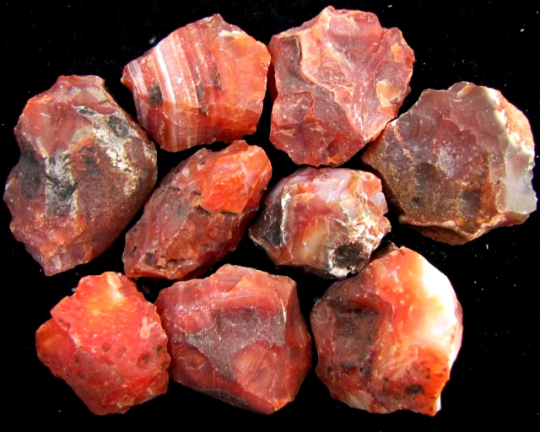
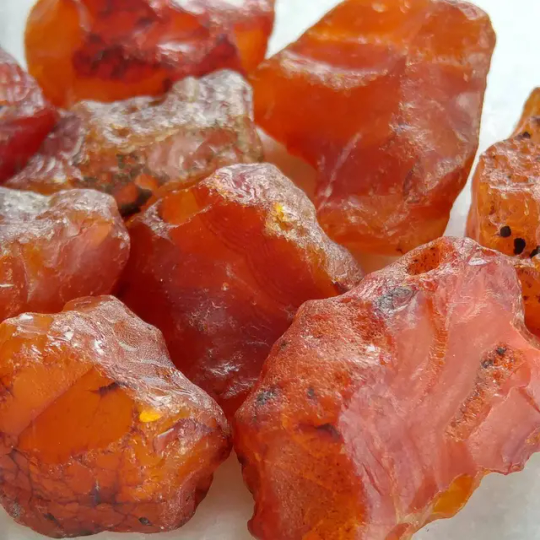
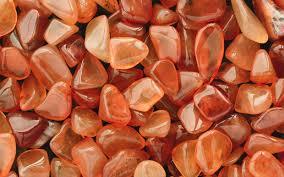
Color: Red, orange, pink, brown
Rarity: Common, easy to obtain
Hardiness: 7
Type: Agate or Chalcedony
Chakra Association: Solar-Plexus, Sacral, Root Chakra
Angels: Michael
Deities: Isis
Astrological Signs: Leo, Taurus, Aries
Element: Fire
Planet: Sun
Origin: Britain, India, Czech Republic, Slovakia, Peru, Iceland, Romania
Powers: Success, Confidence, Motivation, Courage, Sexual Energy, Vitality, Action
Crystals It Works Well With: Aquamarine, Beryl, Super Seven
How It is Created: It is part of the chalcedony family. It is made up of silicon dioxide colored by different levels of iron impurities, with specks, banding, or stripes in many shades of brown or orange-red. The stone itself has a beautiful warm orange color that is best appreciated when it is polished.
History: Since ancient times, carnelian has been polished and worn as jewelry. The Egyptians used it to contrast with onyx and lapis lazuli in the making of collars and necklaces. The Romans were fond of it set in gold, using small beads in earrings or larger polished stones in finger rings for men and women. In the Middle Ages, carnelian was also popular as a healing stone. It was said to dissolve anger or rage, protect the wearer from negative influences, and promote courage.
What It Can Do:
Can be used in spell for success, confidence, and motivation
Can bring a burst of inspiration and energy
Is good for sex magic and sometimes menstrual support
Can cleanse and restore other crystals
Can help those in abusive situations by providing inner strength and movement to the right path
Help with mental preparation with childbirth
Calms angry emotions and puts a stop to mental lethargy
Can restore vitality and remove the fear of death
Was used to protect the dead to their journey to the afterlife
Dispels apathy and motivates success
Improves analytics abilities and clarifies perception
Removes extraneous thoughts in mediation and tunes daydreamers into reality
Can stimulate metabolism and improve your life force
Can influence reproductive organs and increase fertility
How to Get the Best Out Of: Use as a pendant or belt buckle, or place in contact with the skin as appropriate.
How to Cleanse and Charge: You can cleanse and charge carnelian with the sun.
Crystal Grid:
Creativity Grid
Shape: Flower of Life or Vesica Piscis
Mantra: “Creativity flows through me.”
Center Stone: Carnelian sphere or tumbled stone
Secondary Stones: Rainbow moonstone, larimar, kunzite, orange calcite
Moon Phase: Waxing phase or full moon
Day: Wednesday
Sources
#witchblr#witch community#witchcraft#occulltism#paganblr#nature#crystal witch#crystals#gemstone#gems#minerals#crystal grid#geology#spirituality#pagan#goddess isis#witches#witchcraft resources#magick#witches of tumblr#witchcraft 101#carnelian
333 notes
·
View notes
Text

Bizarre Water Tanks from Jalandhar, Punjab, India: There must be something in the water in the Indian state of Punjab, where these bizarre water tanks are a common sight. A tractor, a large flower, and even an enormous airplane can be spotted on the roofs of Punjabi homes. These water tanks help to brighten up the streets in the already vibrant region of Punjab.
89 notes
·
View notes
Text

Sun Wukong, the Monkey King: my design notes [!! click here for the full line-up !!] [click here for just the goodies on tumblr]
also titled, "I underestimated my file sizes" TAT Separate images and info below the read more, beware this is LONG <3
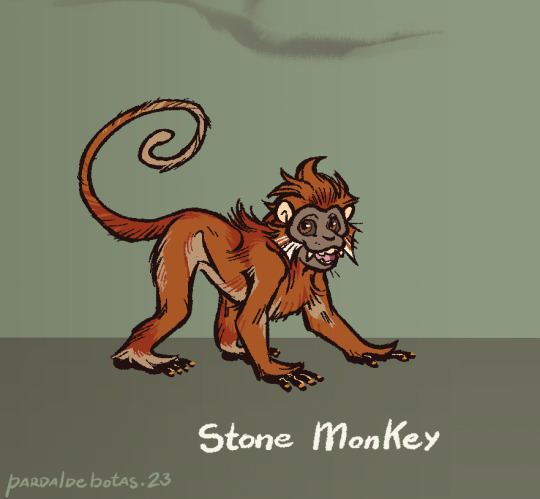
Stone Monkey: himbs baby, that is all <3 he's mostly based off the François Langur, but some of his anatomy and proportions lean more on the Gray Langur and Macaque side of things. His facial fur sort of forms a pentagon shape for the five elements, and I gave him ginger fur cus it's a common depiction for him but also baby langurs are very bright orange, and him not growing dark feels like an apt display of his more childish side, both good and bad. His nails are golden for a bit of a "hidden gem" from a stone egg. Also keeping the tail either in a spiral of C-curve when "engaged", and when droopy it has a feel of a heavy rope. Old World monkeys don't have prehensile tails, he can use it for balance and basic mobility but it's not a third hand for the sake of keeping his monkey-ness.
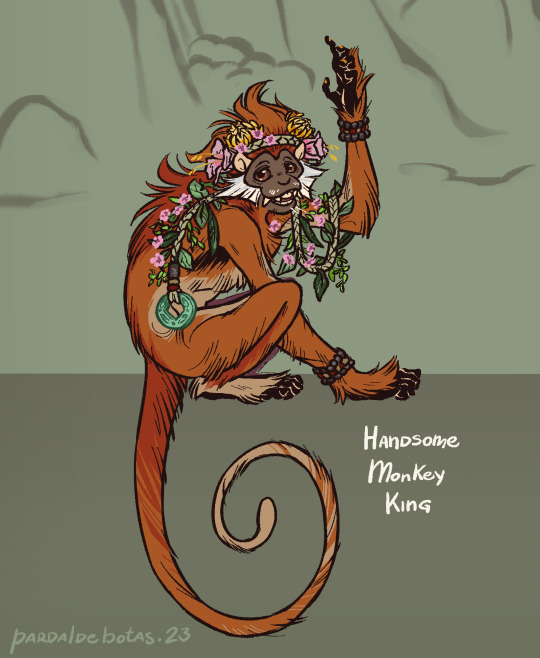
Handsome Monkey King: in one of the poems the monkeys are said to weave grass for mattresses, so I can see them coming up with a crown of woven grass and never-fading leaves and flowers for their king at the very least. His face skin is darker as an adult, but not much else changes overall. The fuzzy upper lips and sideburns are a feature of the species I'm basing him on and it felt like a good fit to add. I also love the forest langurs are so long-furred, makes for a good way to give him dimension but also, the linework style reminds me of old woodcut shorthands for fur. Added a jade coin for the symbolism, and it feels fitting that the king of such a miraculous mountain would have a treasure like that on him. Placcid chill eyes are imperative, dude's not had an existential crisis yet, he's straight up vibing.
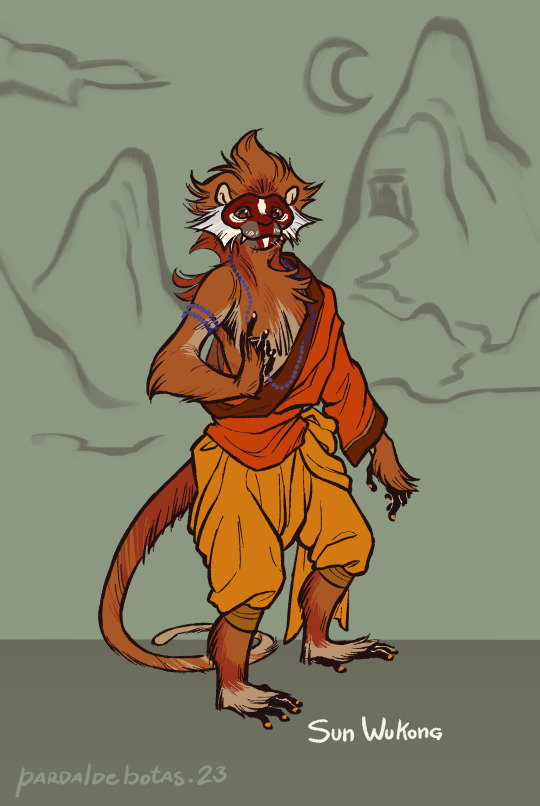
Sun Wukong: during his odd-ten years away from home, he learned human manners so he can stand but, I can see him still needing to lean on his tail to keep up his balance here and there. As he reaches the Western Continent (India) and learns the Way under Patriarch Subodhi, he adopts proper clothes for an apprentice and eventually becomes a Rishi. He dons his facial paint from then on, and after he masters the Way, there's a brightness in his pupils to show his cultivated immortality. The beads are purple solely to stand out over the deluge of oranges that is his design.
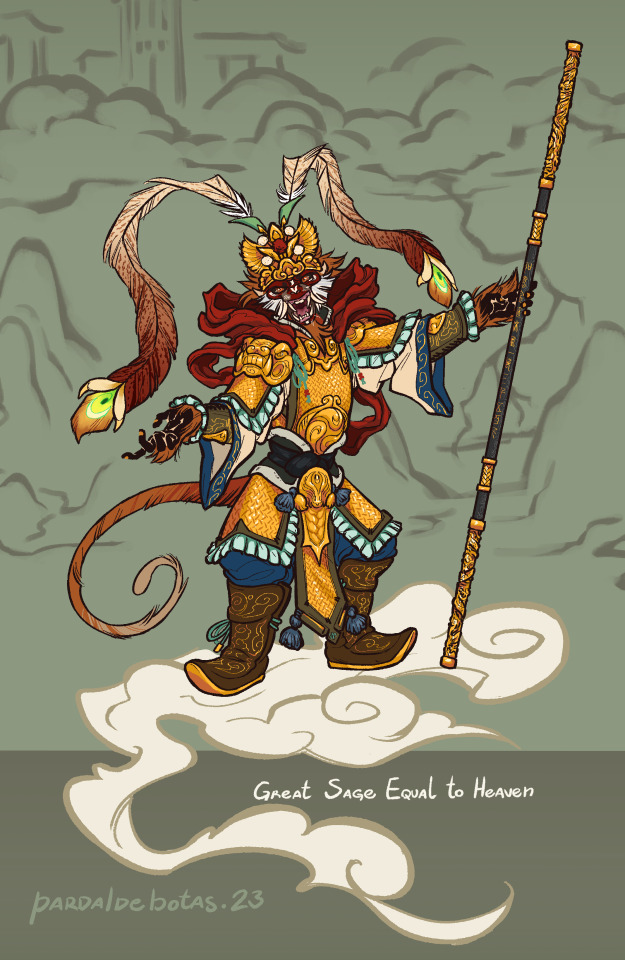
Great Sage Equal to Heaven: really went all out on this one orz this is Wukong at his most egotistical and ambitious, and I wanted his fit to truly embody that. Took bits from Peking Opera costumes and common depiction elements of him, with some bit of extra for appropriate levels of flair, like the phoenix feather design. I wanted to go for a mountain pattern mail but I couldn't figure out how to draw it, so I winged a pattern. I,,, doubt I'll ever draw this armor as detailed as here, but I wanted it to feel a bit overwhelming to look at, while also seeming like it doesn't quite fit him perfectly like it's swallowing him. Bit of a "baby wearing their parent's shoes" kind of vibe; he's stupidly powerful but he doesn't have what it takes to sit on the throne of Heaven. Also I leaned his expression to how he might appear during the Havoc in Heaven and then his bet with the Buddha. Full unbrindled rage murder monkey <3
-- Ruyi Jingu Bang: can't quite move on without my notes on the golden-hooped cudgel, now can I? The secondary hoops are there for further design appeal and for my own visualization of how the staff changes size (the hoops move over the staff's length as if to push it outward or inward). The metal is dark damascus alloy, though the pattern can be omitted for ease of drawing. One hoop end depicts a dragon, the other a phoenix, and in the middle of the staff is the canon inscription as described in the books, in seal script. Glow is optional and mostly for aesthetics.
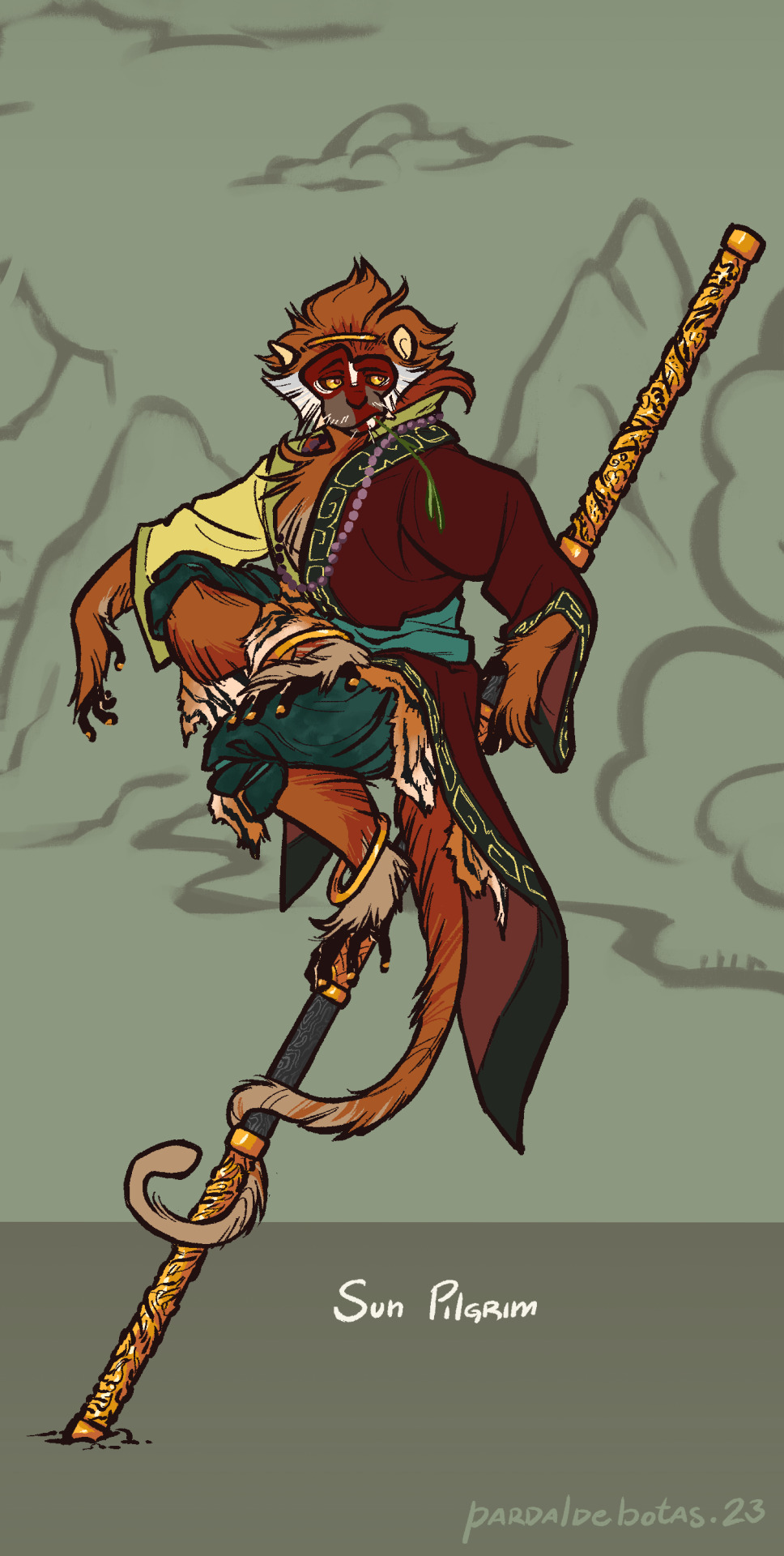
Sun Pilgrim: out of his stolen armor, Wukong seems to swim in his robes but in a less overwhelming way. Went for the simple fillet headband cus his face is busy enough as it is. I know he's skilled enough to skin a tiger into pretty decent squares, but after one too many battles, anything would get tattered. He wears red, teal, black and yellow, four of the five cardinal colors, while white (the West) is still missing. His red and black half-robe doesn't fully cover the yellow underneath, a call back to his golden armor; he tries to use his wisdom and teachings to fight back the impulses of his past, but they still shine through at times. I kept only the leg bangs for dynamic elements to better show movement, but also one could say he's got.... golden hoops (haha get it, like his cudgel?? :oD)
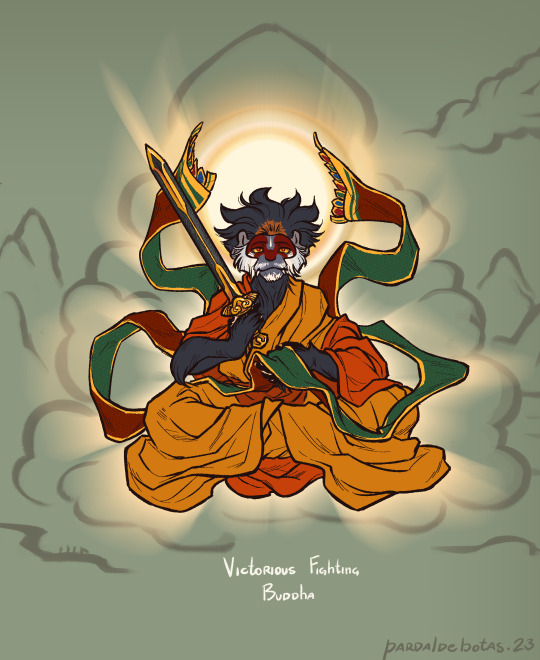
Victorious Fighting Buddha: leaned hard on the actual portrayals of the Buddha. Seeing that he's depicted with dark/blue skin, it felt appropriate to let the guy grow out of his baby ginger fur and into adult black, but a patch remains where the golden headband used to be. I didn't want to give him long hair so no bun, but instead, his fur has a sorta lotus-petals shape now rather than his single point. His face paint changes into a more domino-mask style, and his brow white line resembles a teardrop urna. I made the mail piece he holds longer to keep the flowy bits of his previous outfits, and I turned Ruyi Jingu Bang into the sword he wields.
Hello hi, this robbed me of three days of my life and I'd like to receive compensation x.x Anyway hope you enjoy this lad, I know I do! Also if you wanna send me asks about him pls feel welcome to, I'd love to chat about this bastard monkey (affectionate) (loving) (i`d die for him)
#jttw#journey to the west#xiyouji#jttw sun wukong#sun wukong#jttw fanart#monkey king#stone monkey#victorious fighting buddha#buddha victorious in strife#sun pilgrim#bell dragon art#expedition to the west au
350 notes
·
View notes
Text
I wanna imagine the taskforce coming to India for like a short retreat.
Alejandro and Ruby immediately fit in because apart from the vegetarianism; Spanish and Indian have so many things in common.
They immediately gel well with the community and start exchanging recipes, delicacies and participating in events.
Gaz immediately jumps in in wedding celebrations where the band is playing while the audience walks around the road because celebration in India doesn’t care if you’re known and unknown. He ends up with fifty phone numbers at the end of the night, with five new families calling him “bhai” (brother).
But Soap and Ghost?
Soap takes very eagerly to everything it has to offer, from its rich history to the lost art styles and artisans and handicrafts made in India. It’s so gorgeous, the people are kinder than most and he enjoys himself. And that’s when he finds henna.
Henna, traditionally called mahendi, is a type of art form where they draw intricate patterns on your hands (you can have em done on your feet too if you want) and there’s a bright orange colour that blooms and stays for the next week or so.
Simon gets pulled into it, and blushes when they comment on how handsome he is. Soap wants to try and they teach him, but to practice he immediately takes to practising on himself.
He’s cursing, finding it difficult after a while when Ghost hesitantly holds his hand out and tells him to get it over with.
Soap draws along the scars, making them stand out but surrounding them with vines, flowers and just designs tracing them throughout, as if to show there is still beauty found in the shards.
The colour stays for a while, but Ghost feels amusement and fondness when he looks at his arms, seeing them as beauty for the first time in a long while.
#Simon riley#alejandro cod#rudolfo cod#alejandro mw2#rudy cod#Simon ghost riley#ghost#soap#Johnny mactavish#Johnny soap mactavish#ghostsoap#gaz garrick#Kyle gaz garrick#taskforce 141
254 notes
·
View notes
Text
Herbalism 101: Lavender
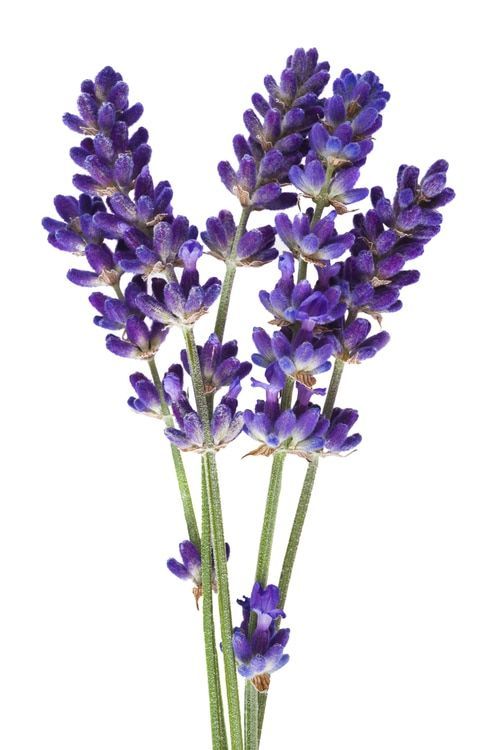
Fun Fact: Lavender is a part of the mint family; making it a natural insect repellent.
English lavender (Lavandula angustifolia) is an excellent way to add a mid-summer pop of color to your garden or patio. Planting is somewhere where you can enjoy its beautiful scent. English lavender is more tolerant of colder temperatures common in the Marquette area than French lavender, making it an excellent choice for herb gardens and perennial borders. This is a member of the mint family features aromatic leaves and flowers that are popular for cooking purposes, medicinal use, and home projects.
Lavender is prized as a culinary ingredient. Lemon and lavender make a great combination for baking cookies, cakes, and other delicacies. Lavender can also be used to infuse simple syrups for cocktails or lemonades.
Lavender’s lovely scent is known to reduce anxiety and calm the mind. The calming fragrance of a lavender plant is thought to provide relief from stress, depression, and migraines. It is also considered anti-inflammatory and has antiseptic properties.
Lavender attracts beneficial pollinators to its flowers. Adding lavender to your garden will attract butterflies, bees, and other helpful insects.
Lavender plants are deer resistant. Making them a welcome addition for many homeowners looking for plants they don’t have to share with the local wildlife.
Lavender from your garden can be dried and used to create items such as homemade lavender soap, bath salts, potpourri, sachets, and cleaning products.
Lavender does well in most climates. The plant is drought resistant and will form a large swath of flowering plants. The blue flowers are not only beautiful but smell fabulous. You can harvest the blooms through the summer and prune the plant back in the fall.
-flower works blog
Lavender is a flowering plant in the mint family that’s easily identified by its sweet floral scent. It’s believed to be native to the Mediterranean, The Middle East, and India, with a history dating as far back as 2,500 years.
According to everyday health blog, Possible health benefits of Lavender include:
May help improve sleep.
Can help treat skein blemishes.
May offer a natural remedy for pain.
Reduce blood pressure and heart rate.
Could relieve asthma symptoms.
Help combat fungus growth.
Potentially promotes hair growth.
Helps relieve stress.
Lavender hasn’t been approved by the FDA, so it’s important to be aware of potential health risks or side effects of using this herb.
📷© Pinterest
#witch#kitchen witch#pagan#witch blog#herbs#witchcraft#kitchen witchery#green witch#hearth witch#herbal magick#witchy#pagan witch#witch aesthetic#witches#witchyvibes#baby witch#cottage witch#earth witch#forest witch#hedge witch#kitchen witchcraft#lunar witch#nature witch#witch community#witch core#witch familiars#witch history#witch tips#witchblr#witchcore
346 notes
·
View notes
Text
DAY 5799
Jalsa, Mumbai Jan 2/3, 2024 Tue/Wed 6:28 AM
🪔 ,
January 03 .. birthday wishes to our Ef and greetings to all ..
Ef Himanshu Srivastava .. Ef Nandkeshor Dattatreya Paatil .. Ef Omnia from Egypt 🇪🇬 .. Ef Anuradha Raheja from Madurai .. and Ef Megha VJ from USA 🇺🇲 ..
.. ✨
🌹

Babuji .. a prominent member of the Freedom Fighters for Independent India .. and how his modest home was opened for secret meetings and a place to hide, for the freedom fighters ..
In one of his conversations with me he did describe how the great freedom fighter Chandrashekhar 'Azaad' had sought refuge at his home and remained rolled up in a 'bistar band' .. बिस्तर बंद .. the 'HoldAll' of my times, a canvas type rolled packaging with straps to tie it up, inside which was laid a mattress, pillows, your shoes and other essentials for travel .. all then rolled up and tied in leather straps, which then became an essential baggage element during travel .. it would and was opened up by releasing the straps, unrolling it and viola, a ready made bed - mattress pillows and all .. open it up on the bed or floor or a train berth .. most convenient and the most important baggage material for travel .. well on train and cars and bus travels .. until the airplane arrived as the more, now common mode of travel ..
So 'Azad' remained rolled up in the 'holdall' - a most convenient and descriptive word coined for this kind of baggage essential - and secretly spent a night there at Babuji's home .. rolled up in a holdall !!
The dedication and will of the freedom fighter ! Incredible !!
Chandrashekhar 'Azad' later took on the British forces, a large contingent, in the famous Allahabad park, then known as Alfred Park, alone, hiding behind a tree, firing bullets from his pistol , until when his ammunition was exhausted and when he felt he would be caught, he ended his life behind that tree, by shooting his last bullet .. at himself .. not wanting to give himself up to the British ..
The park has now been renamed in his honour .. The Chandrashekhar Azad Park ..
I spent a large amount of time at this park, for picnics etc., and this was where the popular Allahabad Flower Show used to be held, where I went with Ma .. she won several cups for Best Garden, and Best Flower, the rose, competition !
I remember seeing that famous tree, behind which Azad took shelter and fought the British contingent ..
The park was a large expanse of green and flowers and trees right almost in the centre of the city .. a canopied structure in the middle of the park, was inhabited by a Band, every Sunday, playing old tunes of the time ..
The park also had a most well kept grass tennis court, where I saw some great International players during their tournament, organised by the Allahabad Civic authorities .. I cannot remember their names .. was too young for that .. but they were from Britain, and some European countries , I think ..
They were invited for a tea reception at Justice Mootham's residence, the then Chief Justice of the Allahabad High Court ..
If my memory does not fail me .. Justice Mootham ! yes that name is correct in memory ..
7 :00 AM
a bit misleading the time , for I have been up since 4 .. loitering about in my room, nursing a muscle pulled back in spasm, unable to sleep or rest .. so a selective spray, that boasts of 'pain relief' within minutes - they all do - was generously applied and ..
And ..
Well, the discomfort remains .. ahahaha ..
🤣🤣🤣
The greetings of the New Year, the greetings for the Birthday have all been overwhelmingly large, and this has provided an enormous amount of space occupation on the mobile .. which as I try to address, is becoming a most arduous task ..
SO ..
may I just acknowledge all that have sent their wishes and greetings here and express my inadequacy in making personal responses ..
PLEASE ..
my gratitude then and my love for this ..
❤️
Laziness persists .. and that induces a temperament , which is difficult to describe ..
The absence of routine may sound odd, but routine puts and gathers the body in a way that keeps it going .. else , one never has a solution as to what can be done to occupy time .. and several essentials loose their essentiality !
Making sense ..
No ..
Well then too bad ! 🥹
Was going to suggest, you get lazy to experience and endorse my words, but that would be so ethically incorrect ..
Hence its a wish for the effervescent day ahead .. and my love 😍

Amitabh Bachchan
PS : I was right .. 👇🏽
Orby Howell Mootham
Sir Orby Howell Mootham (17 February 1901 – 19 July 1995) was a British lawyer, legal writer, and judge who was the Chief Justice of the Allahabad High Court from 1955 to 1961, the third-last British judge to serve in India.
120 notes
·
View notes
Text
Moth of the Week
African Death’s-Head Hawkmoth
Acherontia atropos
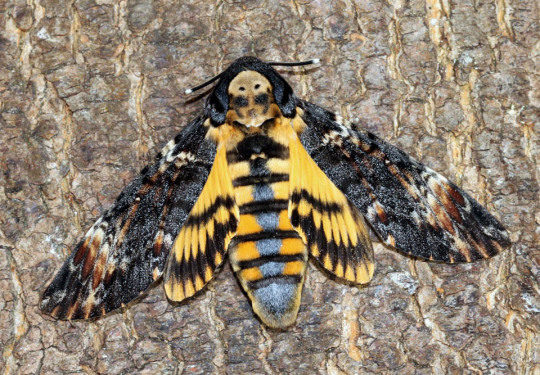
The African death's-head hawkmoth is part of the family Sphingidae and is the most widely recognized of the three species of Death’s-Head Hawkmoth. The species was described in 1758 by Carl Linnaeus. Its common name comes from the skull shape on the back of its thorax. It’s binomial name comes from the river Acheron in Greece, which was believed to lead to the Underworld, and the Greek goddess Atropos respectively.
Description The forewings are black/brown with mottled shades of brown while the hindwings are buff orange with two black/brown stripes that curve with the edge of the hindwing. The head and thorax are the same black/brown color as the forewings interrupted by the brown skull on the back of the thorax. The abdomen is the same buff color as the hindwings with similar stripes of the same color. There is also a single stripe down the center of the abdomen called the “dorsal stripe.”
Average Wingspan: 13 cm (5 in)
Females are large than males with a rounded abdomen tip and larger, thicker antennae
Males have a pointed abdomen tip
Diet and Habitat Larva of this species mainly eat the leaves of potato plants which have alkaloids. The larva accumulate these toxins to become unpalatable to predators. Adults eat the nectar of flowers and stolen honey from the beehives of the Western Honey Bee. They are able to mimic the scent of bees and steal the honey undetected. They use their proboscis, a tube used to drink nectar and honey, to break the honey comb.
Their ranges stretches from the Middle East, as far south as the southern tip of Africa, as far north as southern Great Britain, as far east as India and western Saudi Arabia, and as far west as the Canary Islands and Azores. It is known to move into western Eurasia, but a majority do not survive the winter.
Mating This moth has multiple generations per year. In Africa, the broods are continuous. In the northern range, the larva overwinter in the pupal stage. Eggs are laid singly on the underside of species in mainly Solanaceae but also Physalis, Verbenaceae, Cannabaceae, Oleaceae, Pedaliaceae and others.
Predators This moth can emit a special squeak noise by sucking in air to vibrate a flap in its mouth and throat. The purpose of this squeak is unclear, but the two hypotheses are it is to scare away predators or to mimic the sound of a queen bee makes for the workers to stop moving to easier raid beehives for honey. They are also immune to bee venom and can mimic the scent of bees.
Fun Fact This moth has appeared many times in pop culture as symbols of death and evil:
It appeared in The Hireling Shepherd, Bram Stoker's Dracula, Un Chien Andalou, the promotional marquee posters for The Silence of the Lambs, in the music video to Massive Attack's single, "Butterfly Caught,” and on the American edition's cover of José Saramago's novel Death with Interruptions.
It is mentioned in Susan Hill's Gothic horror novel I'm the King of the Castle and John Keats’s "Ode to Melancholy.”
It is referred to in The Mothman Prophecies.
Finally, the moth is used as a calling card by the serial killer Buffalo Bill. However, in the movie script they are referred to under a different species of death’s-head hawkmoths.
(Source: Wikipedia, Simple English Wikipedia)
#libraryofmoths#animals#bugs#facts#insects#moth#mothoftheweek#lepidoptera#Sphingidae#African death’s-head hawkmoth#Acherontia atropos
170 notes
·
View notes